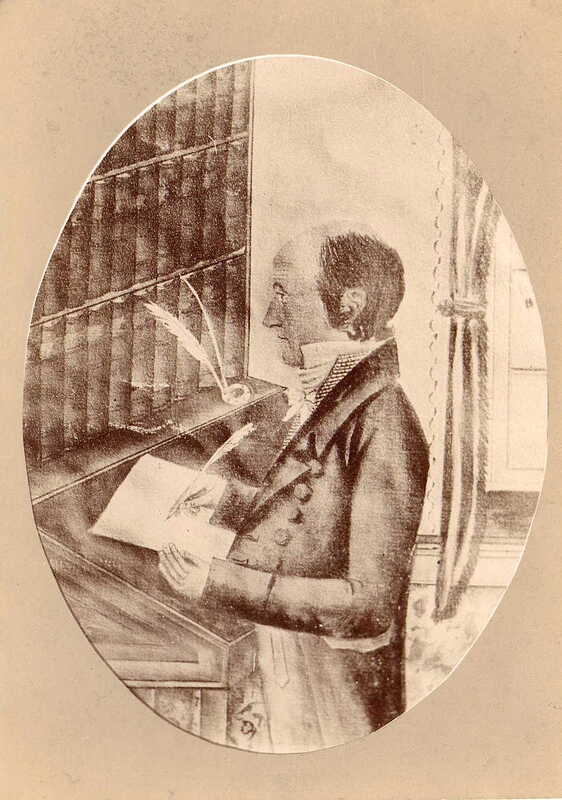|
by John Zimkus, Historian /Education Director of the Harmon Museum
excerpt featured in the Spring 2024 Medallion Newsletter In the late 1920s, when a young Bob Jones purchased the Lebanon Hotel, the old Lebanon House, he had several goals for the old inn. One of them was to restore to the hotel its historic name - The Golden Lamb. Another was to make it a destination restaurant, one that had a strong enough appeal to draw customers from beyond Lebanon, Ohio and the surrounding area. He succeeded with both goals. 100 years earlier, in the 1820s, another innkeeper attempted to make The Golden Lamb the 19th century equivalent of a destination restaurant. His name was Henry Share. Share was born Henrich Sherr in 1763 in the colony of Pennsylvania. In 1820, he and his second wife Mary, also known as Polly, took over the management of The Golden Lamb in Lebanon. The hotel at that time was only about a quarter of the size it is today. Two stories high, it was basically what is covered by The Golden Lamb’s present porch— the lobby, the Dickens Dining Room, the Lebanon Room and the guest rooms on the second floor. It didn’t take long for The Golden Lamb, under Henry Share’s guidance, to be known for its fine food. Henry Share, apparently, was not satisfied with such glowing reviews. He wanted to increase business at his Golden Lamb even more. To him, the answer was theatrical and sideshow attractions. On April 10, 1830, The Western Star newspaper announced: “EGYPTIAN MUMMY To be exhibited for a few days only in the new frame building on the public square, near Mr. Share’s Hotel – commencing on Saturday the 10th inst. There is nothing upon which the living eye can rest more impressive and interesting than the preserved mortal remains of human beings who were inhabitants of earth more than 3,000 years ago. Such are the Egyptian Mummies, embalmed, bandaged, encased, and preserved in excavated recesses of everlasting rock. This mummy was brought to this country by Captain Turner of Charlestown, Mass. from Trieste, at which place it had been received from Thebes. It is very perfect; retaining all its form and features. It stands in the back part of the coffin, wrapped with numerous thickness of the twined linen of Egypt, mentioned in the Scriptures. The envelope is removed from the face, hands and feet. It is of dark color, derived from the embalming material, and not the original color, as the hair is sandy and straight. The coffin is said to be of sycamore wood, covered with Egyptian cement. On the front or lid are various hieroglyphics, supposed to be a biographical account of the deceased person, who according to history, must have lived on this earth 3,000 years ago. The proprietor flatters himself, that no person who has not seen a Mummy, will let this pass without viewing it. Admittance 12 ½ cents.” Captain Larkin Turner brought the Egyptian mummy to the United States in 1824 on his ship Caroline Augusta. Shortly after landing in America, he sold it to Ethan Allen Greenwood, a lawyer and proprietor of the New England Museum in Boston. Greenwood lost no time in sending this new mummy on tour throughout New England in 1824 and to Ohio by 1830. The mummy was brought to the US from Trieste, a city and seaport lying between the Adriatic Sea and Italy's border with Slovenia. In 1830, the time of this ad, Trieste was a prosperous seaport in the Mediterranean region, and the fourth largest city of the Austro-Hungarian Empire. With the collapse of the Empire after World War I, Trieste was annexed to Italy. The mummy came to Trieste from “Thebes,” which is the Greek name of Ancient Egyptian city of Waset. It was located along the Nile River about 500 miles south of the Mediterranean Sea. Thebes (Waset) was the capital of Egypt for long periods during the Middle Kingdom and New Kingdom eras. Thebes’ ruins lie within the modern Egyptian city of Luxor. “12 ½ cents” at this time was called a “bit” equal to one-eighth of a dollar, as in a 25-cent piece, or quarter, being “2 bits.” During the colonial period, the most common unit of currency used in the American Colonies was in fact the Spanish dollar, also known as "piece of eight.” It was worth 8 Spanish silver reales. Spanish coinage, and other foreign coins, continued to be widely used and allowed as legal tender in the United States until the Coinage Act of 1857 was passed by the US Congress. It discontinued the practice repealing all acts "authorizing the currency of foreign gold or silver coins.” 12 ½ cents in 1830, adjusted for inflation, has a value of $3.36 today. Henry Share was perhaps proudest of the fare his Golden Lamb offered. In 1827, he advertised in various newspapers within 100 miles of Lebanon, that the improvements to his “Ohio and Pennsylvania Hotel, SIGN OF THE GOLDEN LAMB” are “not excelled by many in the west, where Ladies and Gentlemen who may think proper to favor him with call, will find good accommodation; he will endeavor by diligent attention to provide his table with the best the country affords, and his bar with the choicest liquors.” Today’s Golden Lamb pledges to its patrons many of the same fine amenities Henry Share’s inn did 200 years ago . . . minus the occasional mummy.
0 Comments
Your comment will be posted after it is approved.
Leave a Reply. |
AuthorVarious staff and volunteer writers. Categories
All
Archives
May 2024
|
Email: info@wchsmuseum.org
Wchs Office/Harmon MuseumTues - Sat: 10am - 4pm
Year Round |
1795 BEEDLE cABINPhone for hours
Year Round |


 RSS Feed
RSS Feed





